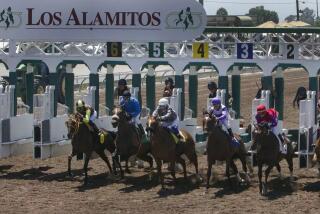Bleeding May Be Race-Horse Killer : Research in Pennsylvania Indicates Syndrome Is Possible Cause of Deaths
Bleeding in race horses--a common syndrome at most tracks--has been identified as a possible major cause of sudden death in a controversial new study that concludes the phenomenon may explain many race-horse deaths previously thought to be heart attacks.
The finding surprised experts at the University of Pennsylvaniaâs New Bolton Center veterinary complex, which headed the research project. The study was published earlier this month in the Journal of the American Veterinary Medical Assn. In a study of nine horses that died at two Pennsylvania tracks between 1981 and 1983, the New Bolton Center team found that bleeding was responsible in every case.
The study said this phenomenon often does not show itself through nosebleeds, as was previously thought. In fact, of the horses studied, only four of nine had visible nosebleeds.
At the two tracks involved in the study, the researchers found, the bleeding syndrome killed horses at the rate of 1 every 1,500 races. Between 45% and 86% of all thoroughbreds show evidence of bleeding when examined through a tube inserted into their chest cavities, the research said.
This raises questions about the relationship between horse deaths and exercise-induced pulmonary hemorrhage (EIPH). Racing officials and medical authorities previously thought all injury-induced deaths were the result of heart attacks, although many veterinarians have suspected EIPH may play a role.
The study was headed by Drs. Corinne Raphel Sweeney and Lawrence Soma, who have been studying the role of bleeding in horse deaths and medical emergencies for more than five years. They urged track veterinarians to exercise greater care in evaluating horses that collapse or die before, during and after races or training workouts or in their stalls while they are unattended.
A review by The Times of more than 300 horses that died or were killed after breakdown injuries at California tracks between December 1985 and mid-June of this year, identified 11 deaths in which EIPH was the apparent or certified cause of death or in which incomplete records indicated the syndrome may have played a role. The records are maintained in Sacramento by the California Horse Racing Board.
The Pennsylvania study dealt only indirectly with the controversy over use of Lasix to control bleeding, and California records showed that some horses who died in bleeding-related incidents were on the drug and some were not.
Soma said that the two tracks involved in the study permitted Lasix use after the research ended in 1983 and that no bleeding deaths have been reported since.
Lasix, a powerful diuretic whose use in humans is controversial because other drugs with fewer side effects are thought to be just as effective, is controversial in horse racing on two fronts. Critics contend there is insufficient evidence that Lasix actually prevents bleeding. They also argue that, because diuretics increase the purging of foreign substances from the body through urine, Lasix use may effectively mask the presence of illegal performance-enhancing drugs in horses.
Whereas the number of bleeding deaths in California was small compared with those who break down on the track, the state records showed that such deaths are by no means rare--even considering the spotty record-keeping. State records are so uneven that medical detail sections of two reports were blank except for a mark in a box next to the word died.
Full autopsies were performed on fewer than a dozen of the California horses because state regulations require horse owners to pay all costs of post-mortem examinations. Those examinations include full analysis of blood and tissue specimens to identify drugs that may have been used on horses before they died.
Soma said the researchers began the study not expecting to find significant numbers of deaths attributable to bleeding.
âWhat was really unexpected was we would find any horses dying of this syndrome,â Soma said. âWe just didnât anticipate it.â
Sweeney was more restrained in her analysis. She declined to characterize the finding as necessarily âsurprising,â calling it âjust one of the first documentations of what one thought was going on.
âWhat weâre saying is that, when a horse dies suddenly, the public always thinks heart attack because they think of comparable situations in people. Most horses donât have (heart attacks) like people do.â
Both Soma and Sweeney questioned whether significant numbers of horses that appear to have breakdown injuries have had medical seizures just before they were hurt. Soma said slow-motion videotapes of injuries generally reveal that a fatal breakdown is preceded by a hyperextension of the leg and that injured horses often slow down after they are hurt and do not completely collapse.
Dr. John Pascoe, a UC Davis equine medicine expert who has studied the use of Lasix, said the new conclusions require more extensive confirmation because the total of deaths in the study was comparatively small. âIt is an interesting study and it adds another piece to the puzzle, so to speak,â Pascoe said. âBut it is not the definitive answer. There is a tremendous number of horses who bleed so I donât think you can read too much into this.â
Taking into account the lengths of meetings at Californiaâs 7 major race tracks and 10 lesser facilities, state records indicate that a horse dies or is destroyed every 2 or 3 racing days. Of 302 cases reviewed by The Times, 244 were the result of breakdown injuries. Most of the rest were because of a variety of medical causes, but the consistently vague entries, including incomplete or missing records of medications, made analysis difficult.
The California ratio of breakdown injuries to medical causes of death appeared to be consistent with totals maintained at New Yorkâs Belmont Park, where a total of 37 horses died in the trackâs 1987 meeting, with 32 of the deaths attributed to breakdown injuries and 5 to medical causes.
Although medication records were often vague and incomplete, it was clear that large numbers of horses that die in California had been given either Lasix or Butazolidin, the controversial pain-reliever whose use has been intensely criticized for its ability to permit a horse to run even when injured.
Lasix can be legally used in every state but New York. California restricts Lasix to horses whose records indicate they are bleeders.
The California records appeared to be consistent with observations by the Pennsylvania research team that found medical causes other than heart attacks--including the largely unrecognized bleeding syndrome--are far more often responsible for horse deaths.
Only 2 of the 41 California horse deaths that were apparently due to strictly medical causes involved heart seizures, whereas EIPH was the listed or apparent cause of death in 4 cases and a possible cause in 7 others. Gastrointestinal tract diseases--most often colic--took the lives of 14 horses.
The official state records listed no cause of death for 10 horses and injuries off the track were responsible for 7 deaths in the period, including 2 horses that were accidentally electrocuted.
In the Pennsylvania study, Sweeney and Soma reviewed every sudden death case at Philadelphia Park (formerly Keystone Park) and Penn National near Harrisburg. The study did not examine any horse put to death after a breakdown injury. Complete autopsies were performed on 11 animals, but 2 of the horses were found to have suffered undiscovered fatal injuries. All of the remaining nine were diagnosed as having EIPH.
Soma said subsequent use of Lasix at the two tracks appears to have reduced the death toll but Sweeney and Soma agreed it is still not clear whether the drug is truly preventive in the majority of horses that use it.
More to Read
Sign up for Essential California
The most important California stories and recommendations in your inbox every morning.
You may occasionally receive promotional content from the Los Angeles Times.










